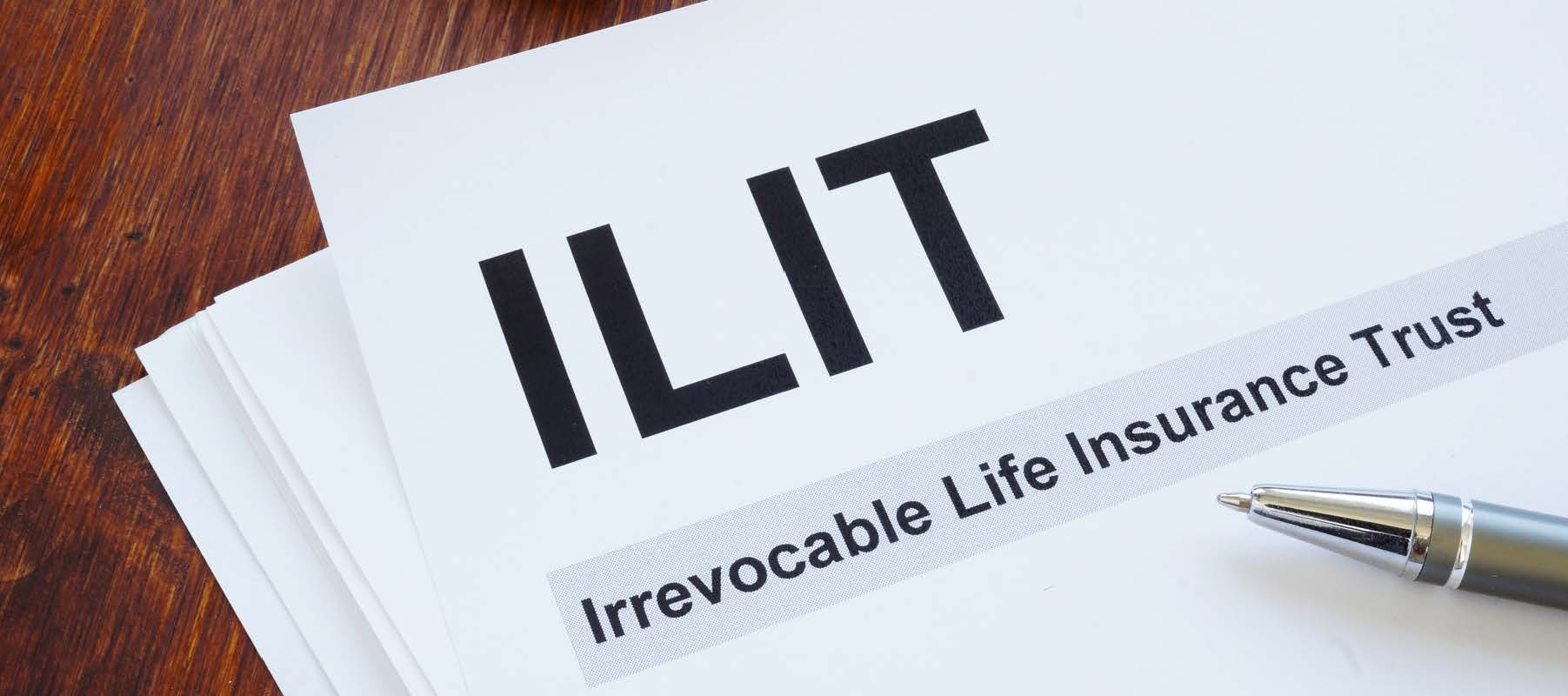Introduction
 Life insurance is often purchased to ensure that loved ones have the financial resources to cover debts, final expenses, and future living costs. However, without proper planning, a significant portion of life insurance proceeds may be lost to federal and state estate taxes. In some cases, as much as 40 percent of the benefit could be diverted from your family to taxes. An Irrevocable Life Insurance Trust, or ILIT, is a legal structure designed to remove life insurance from your taxable estate, ensuring that your beneficiaries receive the full benefit. By transferring ownership of the policy to the trust, you can protect the proceeds from estate taxes while providing a clear plan for how the funds will be managed and distributed.
Life insurance is often purchased to ensure that loved ones have the financial resources to cover debts, final expenses, and future living costs. However, without proper planning, a significant portion of life insurance proceeds may be lost to federal and state estate taxes. In some cases, as much as 40 percent of the benefit could be diverted from your family to taxes. An Irrevocable Life Insurance Trust, or ILIT, is a legal structure designed to remove life insurance from your taxable estate, ensuring that your beneficiaries receive the full benefit. By transferring ownership of the policy to the trust, you can protect the proceeds from estate taxes while providing a clear plan for how the funds will be managed and distributed.
The key is ownership
Generally, all the property you own at your death is subject to federal estate tax. The important point here is that estate tax is imposed only on property in which you have an ownership interest; so if you don’t own your life insurance, the proceeds will generally avoid this tax. This begs the question: Who should own your life insurance instead? For many, the answer is an irrevocable life insurance trust, or ILIT (pronounced “eye-lit”).
What is an ILIT?
An ILIT is a trust primarily set up to hold one or more life insurance policies. The main purpose of an ILIT is to avoid federal estate tax. If the trust is drafted and funded properly, your loved ones should receive all of your life insurance proceeds, undiminished by estate tax.
How an ILIT works
Because an ILIT is an irrevocable trust, it is considered a separate entity. If your life insurance policy is held by the ILIT, you don’t own the policy — the trust does.
You name the ILIT as the beneficiary of your life insurance policy. (Your family will ultimately receive the proceeds because they will be the named beneficiaries of the ILIT.) This way, there is no danger that the proceeds will end up in your estate. This could happen, for example, if the named beneficiary of your policy was an individual who dies, and then you die before you have a chance to name another beneficiary.
Because you don’t own the policy and your estate will not be the beneficiary of the proceeds, your life insurance will escape estate taxation.
Because an ILIT must be irrevocable, once you sign the trust agreement, you can’t change your mind; you can’t end the trust or change its terms.
Creating an ILIT
Your first step is to draft and execute an ILIT agreement. Because precise drafting is essential, you should hire an experienced attorney. Although you’ll have to pay the attorney’s fee, the potential estate tax savings should more than outweigh this cost.
Naming the trustee
The trustee is the person who is responsible for administering the trust. You should select the trustee carefully. Neither you nor your spouse should act as trustee, as this might result in the life insurance proceeds being drawn back into your estate. Select someone who can understand the purpose of the trust and who is willing and able to perform the trustee’s duties. A professional trustee, such as a bank or trust company, may be a good choice.
Funding an ILIT
An ILIT can be funded in one of two ways:
- Transfer an existing policy — You can transfer your existing policy to the trust, but be forewarned that under federal tax rules, you’ll have to wait three years for the ILIT to be effective. This means that if you die within three years of the transfer, the proceeds will be subject to estate tax. Your age and health should be considered when deciding whether to take this risk.
- Buy a new policy — To avoid the three-year rule explained above, you can have the trustee, on behalf of the trust, buy a new policy on your life. You can’t make this purchase yourself; you must transfer money to the trust and let the trustee pay the initial premium. Then, as future annual premiums come due, you continue to make transfers to the trust, and the trustee continues to make the payments to the insurance company to keep the policy in force.
Gift tax consequences
Because an ILIT is irrevocable, any cash transfers you make to the trust are considered taxable gifts. However, if the trust is created and administered appropriately, transfers of $19,000 (in 2025, $18,000 in 2024) or less per trust beneficiary will be free of federal gift tax under the annual gift tax exclusion.
Additionally, each of us has a gift and estate tax applicable exclusion amount, so transfers that do not fall under the annual gift tax exclusion will be free of gift tax to the extent of your available applicable exclusion. The gift and estate tax applicable exclusion amount is equal to the basic exclusion amount of $13,990,000 (in 2025; $13,610,000 in 2024) plus any applicable deceased spousal unused exclusion amount. Both the annual exclusion and the basic exclusion amount are indexed for inflation and may change in future years.
Crummey withdrawal rights
Generally, a gift must be a present interest gift in order to qualify for the annual gift tax exclusion. Gifts made to an irrevocable trust, like an ILIT, are usually considered gifts of future interests and do not qualify for the exclusion unless they fall within an exception. One such exception is when the trust beneficiaries are given the right to demand, for a limited period of time, any amounts transferred to the trust. This is referred to as Crummey withdrawal rights or powers. To qualify your cash transfers to the ILIT for the annual gift tax exclusion, you must give the trust beneficiaries this right.
The trust beneficiaries must also be given actual written notice of their rights to withdraw whenever you transfer funds to the ILIT, and they must be given reasonable time to exercise their rights (30 to 60 days is typical). It’s the duty of the trustee to provide notice to each beneficiary.
Of course, so as not to defeat the purpose of the trust, the trust beneficiaries should not actually exercise their Crummey withdrawal rights, but should let their rights lapse.
The key duties of an ILIT trustee include:
- Opening and maintaining a trust checking account
- Obtaining a taxpayer identification number for the trust entity, if necessary
- Applying for and purchasing life insurance policies
- Accepting funds from the grantor
- Sending Crummey withdrawal notices
- Paying premiums to the insurance company
- Making investment decisions
- Filing tax returns, if necessary
- Claiming insurance proceeds at your death
- Distributing trust assets according to the terms of the trust
The cost and availability of life insurance depend on factors such as age, health, and the type and amount of insurance purchased. Before implementing a life insurance strategy, it would be prudent to make sure that you are insurable.
The use of trusts involves a complex web of tax rules and regulations and usually involves upfront costs and ongoing administrative fees. You should consider the counsel of an experienced estate conservation professional before implementing a trust strategy.
Conclusion
An ILIT can be an effective estate planning tool for preserving the full value of life insurance proceeds for your beneficiaries. By removing the policy from your estate, you reduce or eliminate the estate tax burden while ensuring the death benefit is distributed according to your wishes. The process involves careful legal drafting, proper funding, and ongoing administration, making the guidance of an experienced attorney or estate planning professional essential. When implemented and managed correctly, an ILIT not only safeguards your family’s financial future but also delivers the tax efficiency and control that traditional policy ownership cannot provide.
Scarlet Oak Financial Services can be reached at 800.871.1219 or contact us here. Click here to sign up for our newsletter with the latest economic news.
Source:
Broadridge Investor Communication Solutions, Inc. prepared this material for use by Scarlet Oak Financial Services.
Broadridge Investor Communication Solutions, Inc. does not provide investment, tax, legal, or retirement advice or recommendations. The information presented here is not specific to any individual’s personal circumstances. To the extent that this material concerns tax matters, it is not intended or written to be used, and cannot be used, by a taxpayer for the purpose of avoiding penalties that may be imposed by law. Each taxpayer should seek independent advice from a tax professional based on individual circumstances. Scarlet Oak Financial Services provide these materials for general information and educational purposes based upon publicly available information from sources believed to be reliable — we cannot assure the accuracy or completeness of these materials. The information in these materials may change at any time and without notice.



